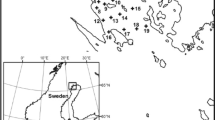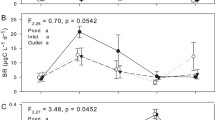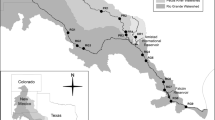Abstract
The fate of allochthonous dissolved organic carbon (DOC) in aquatic systems is primarily controlled by the turnover of heterotrophic bacteria. However, the roles that abiotic and biotic factors such as light and DOC release by aquatic primary producers play in the microbial decomposition of allochthonous DOC is not well understood. We therefore tested if light and autochthonous DOC additions would increase allochthonous DOC decomposition rates and change bacterial growth efficiencies and community composition (BCC). We established continuous growth cultures with different inocula of natural bacterial communities and alder leaf leachates (DOCleaf) with and without light exposure before amendment. Furthermore, we incubated DOCleaf together with autochthonous DOC from lysed phytoplankton cultures (DOCphyto). Our results revealed that pretreatments of DOCleaf with light resulted in a doubling of bacterial growth efficiency (BGE), whereas additions of DOCphyto or combined additions of DOCphyto and light had no effect on BGE. The change in BGE was not accompanied by shifts in the phylogenetic structure of the BCC, but BCC was influenced by the DOC source. Our results highlight that a doubling of BGE is not necessarily accompanied by a shift in BCC and that BCC is more strongly affected by resource properties.



Similar content being viewed by others
References
Cole JJ, Prairie YT, Caraco NF, McDowell WH, Tranvik LJ, Striegl RG, Duarte CM, Kortelainen P, Downing JA, Middelburg JJ, Melack J (2007) Plumbing the global carbon cycle: integrating inland waters into the terrestrial carbon budget. Ecosystems 10(1):172–185. doi:10.1007/s10021-006-9013-8
Freeman C, Evans CD, Monteith DT, Reynolds B, Fenner N (2001) Export of organic carbon from peat soils. Nature 412(6849):785–785. doi:10.1038/35090628
Mack MC, Schuur EAG, Bret-Harte MS, Shaver GR, Chapin FS (2004) Ecosystem carbon storage in arctic tundra reduced by long-term nutrient fertilization. Nature 431(7007):440–443. doi:10.1038/nature02887
Monteith DT, Stoddard JL, Evans CD, de Wit HA, Forsius M, Høgåsen T, Wilander A, Skjelkvåle BL, Jeffries DS, Vuorenmaa J, Keller B, Kopácek J, Vesely J (2007) Dissolved organic carbon trends resulting from changes in atmospheric deposition chemistry. Nature 450(7169):537–540. doi:10.1038/nature06316
Peterson BJ, Holmes RM, McClelland JW, Vörösmarty CJ, Lammers RB, Shiklomanov AI, Shiklomanov IA, Rahmstorf S (2002) Increasing river discharge to the Arctic Ocean. Science 298(5601):2171–2173. doi:10.1126/science.1077445
Porcal P, Koprivnjak J-F, Molot LA, Dillon PJ (2009) Humic substances—part 7: the biogeochemistry of dissolved organic carbon and its interactions with climate change. Environ Sci Pollut Res 16(6):714–726. doi:10.1007/s11356-009-0176-7
Gasith A, Hasler AD (1976) Airborne litterfall as a source of organic matter in lakes. Limnol Oceanogr 21(2):253–258
Attermeyer K, Premke K, Hornick T, Hilt S, Grossart H-P (2013) Ecosystem-level studies of terrestrial carbon reveal contrasting bacterial metabolism in different aquatic habitats. Ecology 94(12):2754–2766. doi:10.1890/13-0420.1
Findlay SEG, Sinsabaugh RL, Sobczak WV, Hoostal M (2003) Metabolic and structural response of hyporheic microbial communities to variations in supply of dissolved organic matter. Limnol Oceanogr 48(4):1608–1617
Del Giorgio PA, Davis J (2002) Patterns in dissolved organic matter lability and consumption across aquatic ecosystems. In: Findlay SEG, Sinsabaugh SL (eds) Aquatic ecosystems: interactivity of dissolved organic matter. Academic Press, San Diego, pp 399–424
Farjalla VF, Marinho CC, Faria BM, Amado AM, Esteves FA, Bozelli RL, Giroldo D (2009) Synergy of fresh and accumulated organic matter to bacterial growth. Microb Ecol 57(4):657–666. doi:10.1007/s00248-008-9466-8
Fonte ES, Amado AM, Meirelles-Pereira F, Esteves FA, Rosado AS, Farjalla VF (2013) The combination of different carbon sources enhances bacterial growth efficiency in aquatic ecosystems. Microb Ecol 66(4):871–878. doi:10.1007/s00248-013-0277-1
Guenet B, Danger M, Abbadie L, Lacroix G (2010) Priming effect: bridging the gap between terrestrial and aquatic ecology. Ecology 91:2850–2861
Bianchi TS (2011) The role of terrestrially derived organic carbon in the coastal ocean: a changing paradigm and the priming effect. Proc Natl Acad Sci 108(49):19,473–19,481
Guillemette F, McCallister SL, Giorgio PA (2013) Differentiating the degradation dynamics of algal and terrestrial carbon within complex natural dissolved organic carbon in temperate lakes. J Geophys Res Biogeosci 118(3):963–973. doi:10.1002/Jgrg.20077
Arrigo KR (1994) Impact of ozone depletion on phytoplankton growth in the Southern Ocean: large-scale spatial and temporal variability. Mar Ecol Prog Ser 114(1–2):1–1. doi:10.3354/Meps114001
Wang L, Lyons J, Kanehi P, Bannerman R, Emmons E (2000) Watershed urbanization and changes in fish communities in southeastern Wisconsin streams. J Am Water Resour Assoc 36(5):1173–1189
Bauer N, Zwirnmann E, Grossart H-P, Hilt S (2012) Transformation and allelopathy of natural dissolved organic carbon and tannic acid are affected by solar radiation and bacteria. J Phycol 48(2):355–364
Paul A, Dziallas C, Zwirnmann E, Gjessing ET, Grossart H-P (2012) UV irradiation of natural organic matter (NOM): impact on organic carbon and bacteria. Aquat Sci 74(3):443–454. doi:10.1007/s00027-011-0239-y
Sulzberger B, Durisch-Kaiser E (2009) Chemical characterization of dissolved organic matter (DOM): a prerequisite for understanding UV-induced changes of DOM absorption properties and bioavailability. Aquat Sci 71(2):104–126. doi:10.1007/s00027-008-8082-5
Bertilsson S, Tranvik LJ (1998) Photochemically produced carboxylic acids as substrates for freshwater bacterioplankton. Limnol Oceanogr 43(5):885–895
Obernosterer I, Benner R (2004) Competition between biological and photochemical processes in the mineralization of dissolved organic carbon. Limnol Oceanogr 49(1):117–124
Pullin MJ, Bertilsson S, Goldstone JV, Voelker BM (2004) Effects of sunlight and hydroxyl radical on dissolved organic matter: bacterial growth efficiency and production of carboxylic acids and other substrates. Limnol Oceanogr 49(6):2011–2022
Pinhassi J, Azam F, Hemphälä J, Long RA, Martinez J, Zweifel UL, Hagström Å (1999) Coupling between bacterioplankton species composition, population dynamics, and organic matter degradation. Aquat Microb Ecol 17(1):13. doi:10.3354/Ame017013
Eiler A, Langenheder S, Bertilsson S, Tranvik LJ (2003) Heterotrophic bacterial growth efficiency and community structure at different natural organic carbon concentrations. Appl Environ Microbiol 69(7):3701–3709. doi:10.1128/aem. 69.7.3701-3709.2003
Jones SEG, Newton RJ, McMahon KD (2009) Evidence for structuring of bacterial community composition by organic carbon source in temperate lakes. Environ Microbiol 11(9):2463–2472. doi:10.1111/j.1462-2920.2009.01977.x
Cottrell MT, Kirchman DL (2000) Natural assemblages of marine proteobacteria and members of the Cytophaga-Flavobacter cluster consuming low-and high-molecular-weight dissolved organic matter. Appl Environ Microbiol 66(4):1692–1697
Brothers SM, Hilt S, Attermeyer K, Grossart H-P, Kosten S, Lischke B, Mehner T, Meyer N, Scharnweber K, Köhler J (2013) A regime shift from macrophyte to phytoplankton dominance enhances carbon burial in a shallow, eutrophic lake. Ecosphere 4(11):art137. doi:10.1890/ES13-00247.1
Sanders RW, Porter KG, Caron DA (1990) Relationship between phototrophy and phagotrophy in the mixotrophic chrysophyte Poterioochromonas malhamensis. Microb Ecol 19(1):97–109
Kamjunke N, Köhler B, Wannicke N, Tittel J (2008) Algae as competitors for glucose with heterotrophic bacteria. J Phycol 44(3):616–623
Hobbie JE, Daley RJ, Jasper S (1977) Use of nuclepore filters for counting bacteria by fluorescence microscopy. Appl Environ Microbiol 33(5):1225–1228
Kamjunke N, Tittel J, Krumbeck H, Beulker C, Poerschmann J (2005) High heterotrophic bacterial production in acidic, iron-rich mining lakes. Microb Ecol 49(3):425–433. doi:10.1007/s00248-004-0270-9
Simon M, Azam F (1989) Protein content and protein synthesis rates of planktonic marine bacteria. Mar Ecol Prog Ser 51(3):201–213. doi:10.3354/meps051201
Kirchman DL, Knees E, Hodson R (1985) Leucine incorporation and its potential as a measure of protein synthesis by bacteria in natural aquatic systems. Appl Environ Microbiol 49(3):599–607
Kirchman DL, Hoch MP (1988) Bacterial production in the Delaware Bay estuary estimated from thymidine and leucine incorporation rates. Mar Ecol Prog Ser 45(1):169–178. doi:10.3354/Meps045169
Pace ML, Cole JJ (1994) Primary and bacterial production in lakes: are they coupled over depth? J Plankton Res 16(6):661–672
Nercessian O, Noyes E, Kalyuzhnaya MG, Lidstrom ME, Chistoserdova L (2005) Bacterial populations active in metabolism of C1 compounds in the sediment of Lake Washington, a freshwater lake. Appl Environ Microbiol 71(11):6885–6899. doi:10.1128/AEM. 71.11.6885-6899.2005
Caporaso JG, Lauber CL, Walters WA, Berg-Lyons D, Huntley J, Fierer N, Owens SM, Betley J, Fraser L, Bauer M, Gormley N, Gilbert JA, Smith G, Knight R (2012) Ultra-high-throughput microbial community analysis on the Illumina HiSeq and MiSeq platforms. ISME J 6(8):1621–1624. doi:10.1038/ismej.2012.8
Masella AP, Bartram AK, Truszkowski JM, Brown DG, Neufeld JD (2012) PANDAseq: paired-end assembler for Illumina sequences. BMC Bioinforma 13(1):31. doi:10.1186/1471-2105-13-31
Martin M (2011) Cutadapt removes adapter sequences from high-throughput sequencing reads. EMBnet J 17:10–12
Caporaso JG, Kuczynski J, Stombaugh J, Bittinger K, Bushman FD, Costello EK, Fierer N, Pena AG, Goodrich JK, Gordon JI et al (2010) QIIME allows analysis of high-throughput community sequencing data. Nat Methods 7(5):335–336. doi:10.1038/nmeth.f.303
Quast C, Pruesse E, Yilmaz P, Gerken J, Schweer T, Yarza P, Peplies J, Glöckner FO (2013) The SILVA ribosomal RNA gene database project: improved data processing and web-based tools. Nucleic Acids Res 41(D1):D590–D596. doi:10.1093/nar/gks1219
Edgar RC (2010) Search and clustering orders of magnitude faster than BLAST. Bioinformatics 26(19):2460–2461. doi:10.1093/bioinformatics/btq461
Chao A, Chazdon RL, Colwell RK, Shen TJ (2005) A new statistical approach for assessing similarity of species composition with incidence and abundance data. Ecol Lett 8(2):148–159. doi:10.1111/j.1461-0248.2004.00707.x
Chen J, Bittinger K, Charlson ES, Hoffmann C, Lewis J, Wu GD, Collman RG, Bushman FD, Li H (2012) Associating microbiome composition with environmental covariates using generalized UniFrac distances. Bioinformatics 28(16):2106–2113. doi:10.1093/bioinformatics/bts342
Price MN, Dehal PS, Arkin AP (2009) FastTree: computing large minimum evolution trees with profiles instead of a distance matrix. Mol Biol Evol 26(7):1641–1650. doi:10.1093/molbev/msp077
Caporaso JG, Bittinger K, Bushman FD, DeSantis TZ, Andersen GL, Knight R (2010) PyNAST: a flexible tool for aligning sequences to a template alignment. Bioinformatics 26(2):266–267. doi:10.1093/bioinformatics/btp636
Oksanen J, Blanchet GF, Kindt R, Legendre P, Minchin P, O’Hara RB, Simpson GL, Solymos P, Stevens MHH, Wagner H (2011) Vegan: community ecology package. Version 2.0-2. R package URL http://www.r-project.org Accessed December
Strome DJ, Miller M Photolytic changes in dissolved humic substances. In: Proceedings: 20 th Congress, Int Ver Theor Angew Limnol Verh, 1978
Bertilsson S, Tranvik LJ (2000) Photochemical transformation of dissolved organic matter in lakes. Limnol Oceanogr 45(4):753–762
Anesio AM, Granéli W, Aiken GR, Kieber DJ, Mopper K (2005) Effect of humic substance photodegradation on bacterial growth and respiration in lake water. Appl Environ Microbiol 71(10):6267–6275. doi:10.1128/AEM. 71.10.6267-6275.2005
Lindell MJ, Granéli W, Tranvik LJ (1995) Enhanced bacterial growth in response to photochemical transformation of dissolved organic matter. Limnol Oceanogr 40(1):195–199
Glaeser SP, Grossart H-P, Glaeser J (2010) Singlet oxygen, a neglected but important environmental factor: short-term and long-term effects on bacterioplankton composition in a humic lake. Environ Microbiol 12(12):3124–3136. doi:10.1111/j.1462-2920.2010.02285.x
Anesio AM, Theil-Nielsen J, Granéli W (2000) Bacterial growth on photochemically transformed leachates from aquatic and terrestrial primary producers. Microb Ecol 40(3):200–208. doi:10.1007/s002480000045
Sun L, Perdue EM, Meyer JL, Weis J (1997) Use of elemental composition to predict bioavailability of dissolved organic matter in a Georgia river. Limnol Oceanogr 42(4):714–721
Danger M, Cornut J, Chauvet E, Chavez P, Elger A, Lecerf A (2013) Benthic algae stimulate leaf litter decomposition in detritus-based headwater streams: a case of aquatic priming effect? Ecology 94(7):1604–1613
Bengtsson MM, Wagner K, Burns NR, Herberg ER, Wanek W, Kaplan LA, Battin TJ (2014) No evidence of aquatic priming effects in hyporheic zone microcosms. Sci Rep. doi:10.1038/srep05187
Attermeyer K, Hornick T, Kayler ZE, Bahr A, Zwirnmann E, Grossart H-P, Premke K (2014) Increasing addition of autochthonous to allochthonous carbon in nutrient-rich aquatic systems stimulates carbon consumption but does not alter bacterial community composition. Biogeosciences 11:1479–1489
Sanders RW, Caron DA, Berninger UG (1992) Relationships between bacteria and heterotrophic nanoplankton in marine and fresh waters: an inter-ecosystem comparison. Mar Ecol Prog Ser 86(1):1–14. doi:10.3354/Meps086001
Gasol JM (1994) A framework for the assessment of top-down vs bottom-up control of heterotrophic nanoflagellate abundance. Mar Ecol Prog Ser 113(3):291–300. doi:10.3354/Meps113291
Jürgens K (1994) Impact of Daphnia on planktonic microbial food webs―a review. Mar Microb Food Webs 8(1–2):295–324
Kirchman DL, Dittel AI, Findlay SEG, Fischer D (2004) Changes in bacterial activity and community structure in response to dissolved organic matter in the Hudson River, New York. Aquat Microb Ecol 35(3):243–257. doi:10.3354/Ame035243
Landa M, Cottrell MT, Kirchman DL, Blain S, Obernosterer I (2013) Changes in bacterial diversity in response to dissolved organic matter supply in a continuous culture experiment. Aquat Microb Ecol 69(2):157–168. doi:10.3354/Ame01632
Gladden JM, Allgaier M, Miller CS, Hazen TC, VanderGheynst JS, Hugenholtz P, Simmons BA, Singer SW (2011) Glycoside hydrolase activities of thermophilic bacterial consortia adapted to switchgrass. Appl Environ Microbiol 77(16):5804–5812. doi:10.1128/AEM. 00032-11
Hsu SB, Hubbell S, Waltman P (1977) A mathematical theory for single-nutrient competition in continuous cultures of micro-organisms. SIAM J Appl Math 32(2):366–383
Jaspers E, Nauhaus K, Cypionka H, Overmann J (2001) Multitude and temporal variability of ecological niches as indicated by the diversity of cultivated bacterioplankton. FEMS Microbiol Ecol 36(2–3):153–164. doi:10.1016/S0168-6496(01)00129-5
Zeng J, Yang L, Du H, Xiao L, Jiang L, Wu J, Wang X (2009) Bacterioplankton community structure in a eutrophic lake in relation to water chemistry. World J Microbiol Biotechnol 25(5):763–772. doi:10.1007/s11274-008-9946-5
Newton RJ, Jones SEG, Eiler A, McMahon KD, Bertilsson S (2011) A guide to the natural history of freshwater lake bacteria. Microbiol Mol Biol Rev 75(1):14–49. doi:10.1128/MMBR. 00028-10
Kirchman DL (2002) The ecology of Cytophaga–Flavobacteria in aquatic environments. FEMS Microbiol Ecol 39(2):91–100. doi:10.1111/j.1574-6941.2002.tb00910.x
Hutalle-Schmelzer KML, Zwirnmann E, Krüger A, Grossart H-P (2010) Changes in pelagic bacteria communities due to leaf litter addition. Microb Ecol 60(2):462–475. doi:10.1007/s00248-010-9639-0
Pérez MT, Sommaruga R (2006) Differential effect of algal-and soil-derived dissolved organic matter on alpine lake bacterial community composition and activity. Limnol Oceanogr 51(6):2527–2537
Zwart G, Crump BC, Kamst-van Agterveld MP, Hagen F, Han S-K (2002) Typical freshwater bacteria: an analysis of available 16S rRNA gene sequences from plankton of lakes and rivers. Aquat Microb Ecol 28(2):141–155. doi:10.3354/Ame028141
Acknowledgments
We kindly acknowledge Yvonne Rosenlöcher and Erika Ruschak for their technical assistance in the laboratory. We also thank the Aquatic Microbial Ecology group and Terralac team both at IGB for their support and discussions. We acknowledge Kirsten Pohlmann and Gabriel Singer for their support with statistical analysis. Chemical analyses were done by the chemical laboratories at the UFZ. R. Mauersberger (Förderverein Feldberg-Uckermärkische Seen e.V.), and R. Tischbier (Stiftung Pro Artenschutz) kindly provided access to the lakes. We thank Soren Brothers for proofreading the manuscript and two anonymous reviewers for their constructive comments, which greatly improved the manuscript. This is publication 013 of the Berlin Center for Genomics in Biodiversity Research. This project was financially supported by the Pact for Innovation and Research of the Gottfried Wilhelm Leibniz scientific community (project TerraLac, http://terralac.igb-berlin.de).
Author information
Authors and Affiliations
Corresponding author
Rights and permissions
About this article
Cite this article
Attermeyer, K., Tittel, J., Allgaier, M. et al. Effects of Light and Autochthonous Carbon Additions on Microbial Turnover of Allochthonous Organic Carbon and Community Composition. Microb Ecol 69, 361–371 (2015). https://doi.org/10.1007/s00248-014-0549-4
Received:
Accepted:
Published:
Issue Date:
DOI: https://doi.org/10.1007/s00248-014-0549-4




